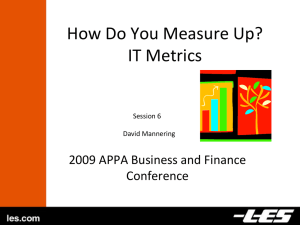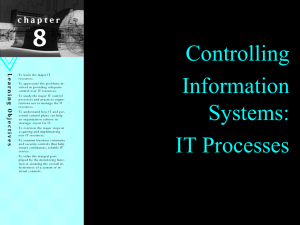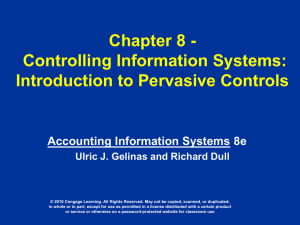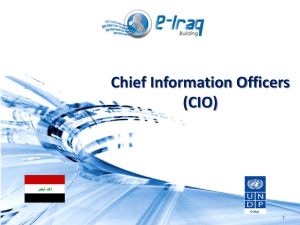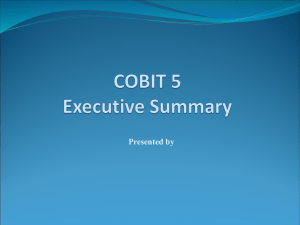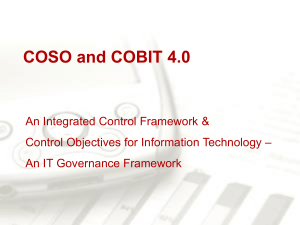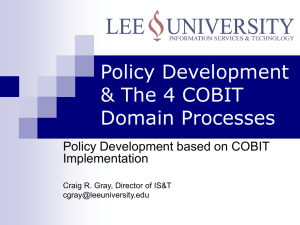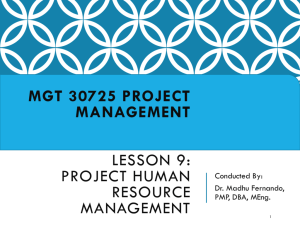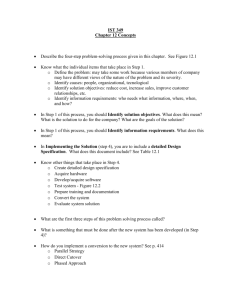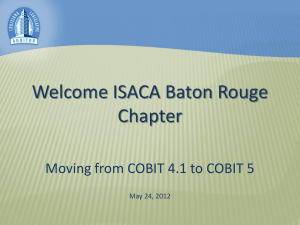COBIT Presentation - Office of the Vice
advertisement
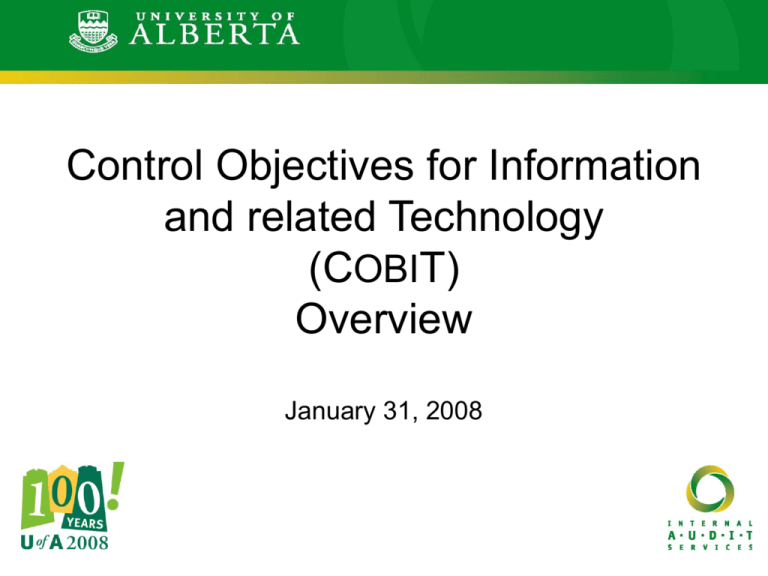
Control Objectives for Information and related Technology (COBIT) Overview January 31, 2008 Overview • Background – trends in auditing affecting IT • Overview of the COBIT • Linkages to other methodologies • Practical application – in audit and IT management Auditing Trends Audit Committees – Increasing dependence on IT infrastructure to support traditional assurance/auditing – Increasing obligations regarding risk management and control including IT – Uses Internal Audit to give assurance – we adopted COBIT with the ability to use other frameworks as deemed appropriate – Management has a role as well Office of the Auditor General – Comments to entities who have been broad IT assessment include ensuring the following is in place: • • • • IT strategies (not just for centralized IT services) Integration of IT requirements into business planning Documented IT risk assessments Business continuity planning and emergency response planning • Service level performance measures • Processes to build awareness for IT internal controls and security • An IT control framework (recommended to several organizations) – recommended COBIT and being adopted COBIT Overview1 IT Governance Institute Enterprise governance is a set of responsibilities and practices exercised by the board and executive management with the goal of: • Providing strategic direction • Ensuring that objectives are achieved www.itgi.org www.itgi.org RESOURCE MANAGEMENT 1 • Ascertaining that risks are managed appropriately • Verifying that the enterprise’s resources are used responsibly This information and that on the following slides is consolidated from information developed by the IT Governance Institute. Major COBIT Elements - IT Processes - Business Requirements - IT Resources IT Processes 1. COBIT describes the IT life cycle with the help of four domains: – Plan and Organize – Acquire and Implement – Deliver and Support – Monitor and Evaluate 2. In each domain are processes are series of activities. There are 34 processes specifying what the business needs to achieve its objectives. 3. The last activities are actions that are required to achieve measurable results with the processes. Plan and Organise Acquire and Implement Plan and Organise IT Processes Deliver and Support Monitor and Evaluate PO1 Define a strategic IT plan. PO2 Define the information architecture. PO3 Determine technological direction. PO4 Define the IT processes, organisation and relationships. PO5 Manage the IT investment. PO6 Communicate management aims and direction. PO7 Manage IT human resources. PO8 Manage quality. PO9 Assess and manage IT risks. PO10 Manage projects. Acquire and Implement Plan and Organise Acquire and Implement IT Processes Deliver and Support Monitor and Evaluate AI1 Identify automated solutions. AI2 Acquire and maintain application software. AI3 Acquire and maintain technology infrastructure. AI4 Enable operation and use. AI5 Procure IT resources. AI6 Manage changes. AI7 Install and accredit solutions and changes. Deliver and Support DS1 Define and manage service levels. DS2 Manage third-party services. DS3 Manage performance and capacity. DS4 Ensure continuous service. DS5 Ensure systems security. DS6 Identify and allocate costs. DS7 Educate and train users. DS8 Manage service desk and incidents. DS9 Manage the configuration. DS10 Manage problems. DS11 Manage data. DS12 Manage the physical environment. DS13 Manage operations. Acquire and Implement Plan and Organise IT Processes Deliver and Support Monitor and Evaluate Monitor and Evaluate Acquire and Implement Plan and Organise ME1 Monitor and evaluate IT performance. ME2 Monitor and evaluate internal control. ME3 Ensure compliance with external requirements. ME4 Provide IT governance. IT Processes Deliver and Support Monitor and Evaluate Business Requirements Effectiveness Efficiency Deals with information being relevant and pertinent to the business process as well as being delivered in a timely, correct, consistent and usable manner Concerns the provision of information through the optimal (most productive and economical) use of resources Confidentiality Concerns the protection of sensitive information from unauthorised disclosure Integrity Relates to the accuracy and completeness of information as well as to its validity in accordance with business values and expectations Availability Relates to information being available when required by the business process now and in the future. It also concerns the safeguarding of necessary resources and associated capabilities. Compliance Deals with complying with those laws, regulations and contractual arrangements to which the business process is subject, i.e., externally imposed business criteria as well as internal policies Reliability Relates to the provision of appropriate information for management to operate the entity and to exercise its fiduciary and governance responsibilities IT Resources Applications Information Infrastructure People Use of COBIT in Internal Audit • Annual Risk Assessment (developed with Grant Thornton) • Can audit difference ways: – a application system (all processes) – a process (e.g. IT investment management across a unit or the campus) – a resource component (e.g. infrastructure) and/or a business requirement (e.g. security) • Maps to other frameworks Flexible yet defensible Use of COBIT in Management • Seeing an increase in formal adoption of frameworks. • Supporting documentation being developed for management. • Flexible adoption – one size does not fit all. • Can be blended with other framework. Organisations will consider and use a variety of IT models, standards and best practices. COSO COBIT ISO 17799 ISO 9000 WHAT ITIL SCOPE OF COVERAGE IT Process Capability Maturity Scorecard—Example IT Process Capability Maturity Initial Plan and Organise PO1 Define a strategic IT plan. PO2 Define the information architecture. PO3 Determine the technological direction. PO4 Define the IT process, organisation and relationships. PO5 Manage the IT investment. PO6 Communicate management aims and direction. PO7 Manage IT human resources. PO8 Manage quality. PO9 Assess and manage risks. PO10 Manage projects. Acquire and Implement AI1 Identify automated solutions. AI2 Acquire and maintain application softw are. AI3 Acquire and maintain technology infrastructure. AI4 Enable operation and use. AI5 Procure IT resources. AI6 Manage changes. AI7 Install and accredit solutions and changes. Deliver and Support DS1 Define and manage service levels. DS2 Manage third-party services. DS3 Manage performance and capacity. DS4 Ensure continuous service. DS5 Ensure systems security. DS6 Identify and allocate costs. DS7 Educate and train users. DS8 Manage service desk and incidents. DS9 Manage the configuration. DS10 Manage problems. DS11 Manage data. DS12 Manage the physical environment. DS13 Manage operations. Monitor and Evaluate ME1 Monitor and evluate IT performance. ME2 Monitor and evaluate internal control. ME3 Ensure compliance w ith external requirements. ME4 Provide IT governance. Repeatable Defined Managed Optimised BUSINESS OBJECTIVES AND GOVERNANCE OBJECTIVES C ME1 ME2 ME3 ME4 Monitor and evaluate IT performance. Monitor and evaluate internal control. Ensure compliance with external requirements. Provide IT governance. O B I T FRAMEWORK PO1 PO2 PO3 PO4 INFORMATION Integrity Efficiency Effectiveness Compliance Availability Confidentiality Reliability PLAN AND ORGANISE MONITOR AND EVALUATE DS1 DS2 DS3 DS4 DS5 DS6 DS7 DS8 DS9 DS10 DS11 DS12 DS13 Define and manage service levels. Manage third-party services. Manage performance and capacity. Ensure continuous service. Ensure systems security. Identify and allocate costs. Educate and train users. Manage service desk and incidents. Manage the configuration. Manage problems. Manage data. Manage the physical environment. Manage operations. IT RESOURCES Applications Information Infrastructure People DELIVER AND SUPPORT Define a strategic IT plan. Define the information architecture. Determine technological direction. Define the IT processes, organisation and relationships. PO5 Manage the IT investment. PO6 Communicate management aims and direction. PO7 Manage IT human resources. PO8 Manage quality. PO9 Assess and manage IT risks. PO10 Manage projects. AI1 AI2 ACQUIRE AND IMPLEMENT AI3 AI4 AI5 AI6 AI7 Identify automated solutions. Acquire and maintain application software. Acquire and maintain technology infrastructure. Enable operation and use. Procure IT resources. Manage changes. Install and accredit solutions and changes. Questions Contact: Ian Simpson Systems Auditor 492-2980
